Published
on 18
Feb 2011
|
All rights reserved.
|
|
|
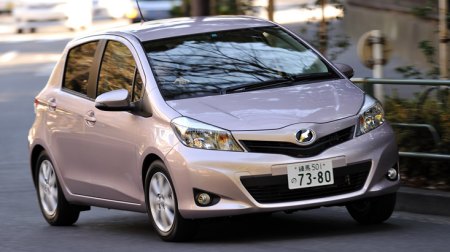 |
|
If
Toyota wants to claw back the lost reputation and market share with the
new Vitz and Yaris, it must be childish...
|
|
For
3 decades Toyota
failed to crack into the small car market with its mediocre Starlet. In
1999, it called the end to the Starlet line and replaced it with Vitz,
or Yaris in Europe. It immediately became a hit. European crowned it
Car of the Year thanks to its funky styling and innovative, highly
efficient packaging. It established a good reputation and sales
prospered globally. A new era was born.
Unfortunately, the second generation born in 2005 did not take the game
to higher level. It gradually fell behind Honda Fit (Jazz) and new
waves of European superminis. However, I suppose that was not the end
of its decline. What you see here is probably worse…
This is the Mk3 Vitz and Yaris. If Toyota wants to claw back the lost
reputation and market share with them, it must be childish. Today's
competition is so intense. If you want to build a class winner, you
have to upgrade build quality, refinement and safety significantly. You
also need to develop a full line of green engines, joining the trend of
downsized turbocharged or direct injection engines. Automatic engine
stop-start is a must. Exterior looks shall be more creative than ever,
while interior shall feel as classy as big cars. In the new Vitz /
Yaris, we found few signs of these elements.
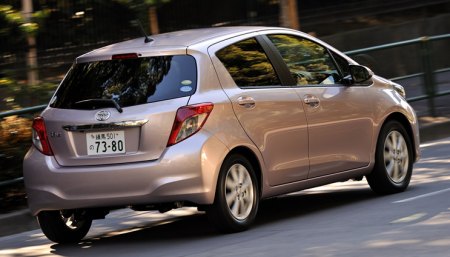 |
|
While
Hyundai-KIA raises their game significantly in recent years, Toyota
keeps designing ugly cars.
|
|
Take the engine range for example. Among the three petrol engines on
offer – 69hp 1.0 three-pot VVT-i, 95hp 1.33 DVVT-i and 109hp 1.5 VVT-i,
only the 1.33-liter unit gets automatic engine stop-start to boost fuel
economy in urban area. The other two are old engines. Equally unlikable
is the fun-killing CVT. When will Toyota introduce DSG ?
Styling is very important these days. While Hyundai-KIA raises their
game significantly in recent years, Toyota keeps designing ugly cars.
The home-grown Mk3 is more angular and edgier than the last two
generations. The concept behind is clearly to attract matured male
buyers. In Japan, there is a trend of downsizing. More and more mid-age
men shift from their Corollas and Civics to B-segment small cars due to
depressed economy. While the attempt to catch these customers are not
wrong, the execution is poor. This is evident from the Japanese
homepage of Vitz, which shows two 30-something men standing in front of
the car. From their dressing, hairstyle and body language we can see
they tried too hard to look cool. That delivers an old-fashioned, 1980s
Japanese pop stars feel. It is the outdated thinking of its chief
engineer produced such an outdated design. The Vitz / Yaris does look
edgy, but not sporty, let alone "heart up". Its lack of character and
progress makes it easily forgettable. I'm afraid on the one hand it may
fail to attract men, on the other hand it may turn off traditional
female buyers and young people. This is a sharp contrast to Honda Fit /
Jazz, which manages to satisfy all kinds of people.
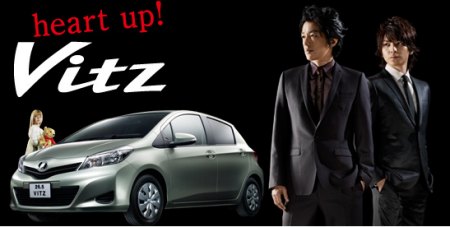 |
|
From
their dressing, hairstyle and body language we can see they tried too
hard to look cool. That delivers an old-fashioned, 1980s Japanese pop
stars feel.
|
|
That said, the exterior design is not the worst aspect of the car. The
interior is. To put it in one word: disaster. If you want to see which
new cars still employ shinny hard plastics all over its cabin, you
don't need to go to China or India. Just look at this one. It looks
cheap and feels cheap in your hands. The interior design is
uninspiring, too, and there are few fancy kits to raise your interest.
Its cheapness is the answer to high yen.
Well, the lack of quality upgrade at least keeps weight in check. The
Vitz weighs around 1000 kg, undercutting all rivals bar the brilliant
Mazda 2. In addition to a low Cx of 0.285, performance should be okay.
Cabin space is also competitive. A stretch of wheelbase by 50 mm and
overall length by 135 mm put it to closer to its European rivals.
Although much of the gain is spent to front overhang to improve crash
protection, thinner backrest helps liberating rear seat legroom by a
valuable 35 mm.
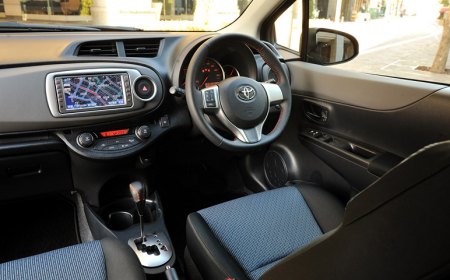 |
|
The
exterior design is not the worst aspect of the car. The interior is. To
put it in one word: disaster.
|
|
On the road, the Vitz / Yaris continues to disappoint. Although NVH
suppression is clearly improved, it is not as good as its European
rivals. Performance is modest for the 1.0 and 1.33-liter engine,
especially because they pair with the lazy CVT. Neither is the
1.5-liter strong. It looks powerful enough on paper, but in reality its
power delivery is peaky and the lack of low-down torque is obvious
against those small turbocharged engines on its rivals. It's a joke to
put this engine under the bonnet of RS trim, unless RS meant "Really
Slow".
Apart from performance, the chassis is also short of fun. The electric
power steering is non-linear and numb. The suspension setting, at least
on the Japanese car, is biased strongly towards the comfort side, thus
lacks a crisped body control. A Mazda 2 or Suzuki Swift is more fun to
drive.
European Yaris will be set sportier, but even so we don't expect it to
match a Ford Fiesta or VW Polo.
So the Mk3 Vitz / Yaris is disappointing. It looks uninspiring, it
drives unremarkably and, perhaps the worst of all, its cabin feels
cheap. Seems that the days of Starlet have returned.
|
Verdict:   |
Published
on 27
Sep 2014
|
All rights reserved.
|
|
Yaris / Vitz facelift 2014
|
|
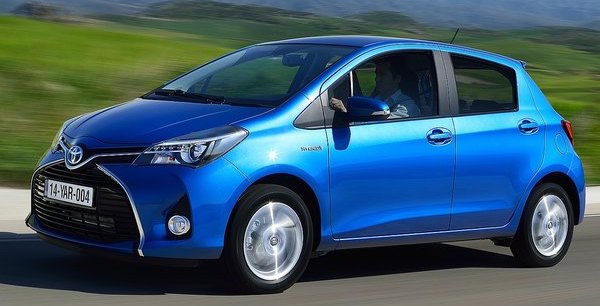
|
|
I
doubt if the aggressive fascia delivers the right message about the
actual character of the car, which is more focused on fuel economy.
|
|
The 3rd generation
Yaris / Vitz born in 2011 was really disappointing. It was ugly outside
and cheap-looking inside. It lacked firepower as well as refinement. No
wonder I rarely see it on streets. Considering how poor it was, the
mid-life facelift has a lot of work to do. Frankly, only an all-new
generation can sort out all the problems, but we hope the facelift can
at least shorten the gaps from the class norm and bring Toyota back to
the mid-pack of one of the most important market segments.
Design and engineering of the facelift is led by the European operation
of Toyota located in France and Belgium, though the updated engines
come straight from Japan. Outside, the cosmetic change is so obvious
that I guess no need to describe. It’s nearly as radical as the new
Aygo, though I doubt if the aggressive fascia delivers the right
message about the actual character of the car, which is more focused on
fuel economy. Anyway, it is definitely more interesting to look.
The interior is also restyled. Although the basic architecture remains,
the instrument pod gets a nice reshape and the door panels look more
stylish – sadly, the latter is absent on Japanese and American cars.
The horizontal dash panel is now made of soft-touch plastic.
Unfortunately, most other surfaces are still finished in hard plastics
of varying grains. Overall speaking, this cabin still lags a long way
behind the standards set by VW Polo and Peugeot 208.
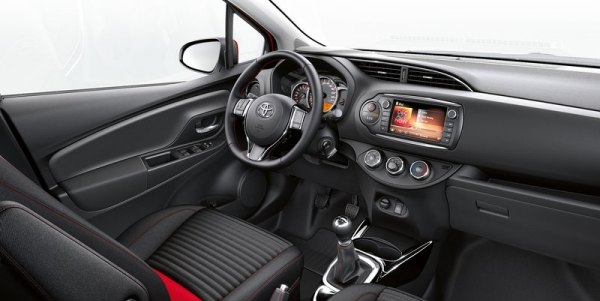
|
|
More
soft plastic aside, this cabin still lags a long way behind the
standards set by VW Polo and Peugeot 208.
|
|
To improve running refinement, Toyota strengthened the chassis in
various locations. For example, it added 36 welding spots to the center
and rear of the monocoque. It reinforced the dashboard supporting beam
and the central tunnel. A new windscreen bonding material also helps
improving rigidity. As for suspension, softer springs should improve
ride quality, while new dampers with rebound springs and a stiffer
torsion beam axle should keep body motions in check. In reality, the
car does offer a more forgiving low-speed ride, but it fails to settle
over high speed bumps. This means it is better to limit its usage in
town. Toyota said the electric-assisted steering has been retuned, but
it is just as numb as before.
We hope the Yaris / Vitz could add some more firepower. Unfortunately,
Toyota concentrated on fuel economy. The core 1.33-liter petrol engine
used in the Japanese car has been overhauled and developed into a new
Atkinson-cycle unit with codename 1NR-FKE. Unlike other Atkinson
engines though, it employs an unusually high compression ratio of
13.5:1 so that it can produce 99 hp, i.e. same as the old engine still
employed by the European version. To make possible the high compression
ratio, it employs very long, 4-2-1 exhaust manifolds (an idea copied
from Mazda Skyactiv-G), water jacket spacer at the combustion chambers
(to reduce temperature), high-tumble port (to speed up combustion) and
cooled exhaust gas recirculation. It also gets low-friction pistons and
chains to enhance efficiency. Besides, its intake variable cam-phasing
has been switched from hydraulic to electric actuated thus gets a new
name, VVT-iE. Performance is practically unchanged, but fuel economy is
improved by 20 percent according to Japanese combined cycle.
The base 1.0-liter 3-cylinder is also improved in efficiency, if not as
radical. It gets the same low-friction components, cooled EGR and
high-tumble port design to enable a higher, 11.5:1 compression.
The 1.5 VVT-i engine available in Japan and US is unchanged, ditto the
hybrid powertrain on the Hybrid model (it is transplanted straight from
Aqua / Prius C). All Yaris /
Vitz remain slow and lacking driver appeal.
|
Verdict:   |
Published
on 10
May 2017
|
All rights reserved.
|
|
Yaris / Vitz facelift 2017
|
|
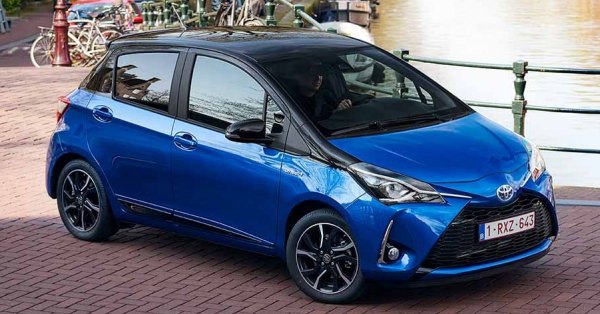
|
|
Although
it is already 6 years old, Toyota considered another facelift would be
sufficient to keep its sales momentum.
|
|
A mainstream car in the
most competitive segment receiving a facelift at its 6th birthday is
abnormal, especially its maker is Toyota, which used to 4-year model
cycle. Not that the Yaris/Vitz is poor selling. Although it is not
going to chase for segment crown, Toyota has just celebrated the sale
of 2 million copies of Vitz in Japan, while in Western Europe it sold
208,000 units of Yaris last year, not bad for a 6-year-old kid, thanks
largely to the segment-unique Hybrid model that accounted for 40
percent of its sales. As there is no sign of decline, Toyota considered
another facelift would be sufficient to keep its sales momentum.
This is the second facelift of the Mk3 model. It is not quite as
radical as the last one introduced 2.5 years ago, but nonetheless a
more thorough revision than the industrial norm. It introduces 900 new
parts and costs €90 million to develop. Toyota’s studio in France is
once again responsible for styling, which improves its aesthetic by
discarding the chromes surrounding the bulldog fascia and add back some
chromes around the foglights. A new two-tone color option has the roof
painted black to smart it up considerably, as well as color-coding the
dashboard panel and upholstery to match the exterior paint. Look is no
longer a problem for the Yaris and Vitz.
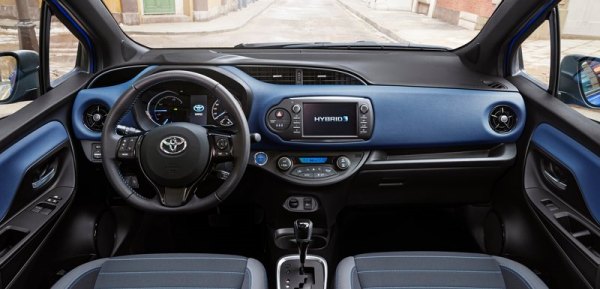
|
|
Small
improvement aside, overall this is still an outdated interior...
|
|
The interior design is basically unchanged, although the color coding
improves the ambience and a bit more soft-touch plastics enhance
tactile quality a little. However, overall this is still an outdated
interior, lacking the visual appeal of, say, Peugeot 208 and Nissan
Micra, as well as the perceived quality of most of its top rivals.
Toyota’s Touch 2 touchscreen infotainment system is also a cheap one.
It is suffering from a wide range of problems, i.e. glare, small
screen, slow response, unintuitive interface design and lack of Apple
CarPlay / Android Auto. A new TFT info display added between the dials
claws back some points, but not enough to save the game. The cabin is
also suffering from high-mounted seats and insufficient reach
adjustment for the steering wheel. These issues have not been addressed
by the facelift.
Under the bonnet, the 69hp 1.0-liter 3-cylinder remains. The 1.4D-4D
diesel has been dropped due to the success of Hybrid. However, the
biggest news is that in Europe the 1.33-liter petrol has been replaced
with a new 1.5-liter engine that comes from the ESTEC family of
high-efficiency engines. Despite of upsizing, its fuel consumption is
claimed to be up to 12 percent lower than the 1.33 engine. How is this
achievable? The answer is using Atkinson cycle. Its intake variable cam
phasing is implemented electrically (VVT-iE) so that it can delay the
intake valve closure in a fraction of a second, hence switching from
Otto cycle to Atkinson cycle. Under higher loads, the engine reverts to
Otto cycle to deliver maximum power, which is 111 hp and 100 lbft,
equaling to Toyota’s existing 1.5 VVT-i unit. By using water-cooled
exhaust gas recirculation to reduce the likelihood of knock, it can
adopt a 13.5:1 compression ratio to enhance power. Overall, the new
engine achieves a thermal efficiency of 38.5 percent, a bit lower than
the 40 percent benchmark of the 1.8-liter unit on Prius. Compared with
the outgoing 1.33-liter, it not only saves fuel but also improves 0-60
mph acceleration by 0.8 seconds.
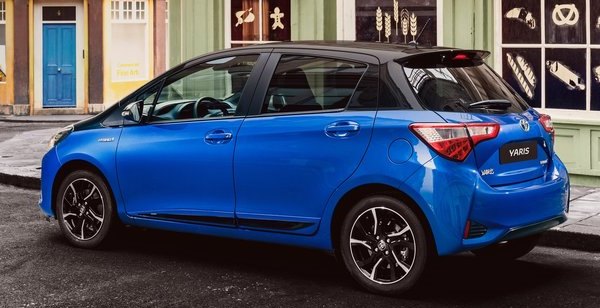
|
|
Against
the trend, Toyota opts for upsizing its engine but it manages to
improve performance and cut fuel consumption simultaneously.
|
|
That said, the Yaris 1.5 is still far from entertaining to drive. While
it is certainly quicker than before, it is no match with its much
torquer turbocharged rivals. You also need to stretch the rev to
deliver the required overtaking punch, by the time the engine becomes
uncomfortably noisy. In fact, the outdated architecture of the car
lacks the necessary NVH suppression to be competitive against its
current rivals. Its door mirrors generate excessive wind noise on
highway. Its window sealing and sound deadening materials seem to be
lacking. The suspension also rides noisily over ridges on highway. The
higher the speed, the more unrefined it appears against its rivals.
This is still essentially a city car.
Toyota spent more effort to improve the NVH and handing of the Hybrid
model, which is admittedly undeveloped last time. Regarding the
1.5-liter petrol model, only a new engine mount and retuned shock
absorbers have been introduced, but they don’t do any miracles. There
is a lot of body movement through corners, and the car is unsettling
over high-speed undulations. The steering is light, inconsistently
weighted and lack of communication. The engine feels strained at upper
rev range, and the 6-speed manual is not exactly slick. The car cannot
be pushed hard, nor
you will feel joyful to do so. To those motorists demanding an
entertaining drive, the Mk3 Yaris/Vitz has long passed its golden time,
if there was any. Toyota should have renewed the car long ago, not
counting on the sales of Hybrid to extend its life.
|
Verdict:   |
Published
on 12
Jan 2018
|
All rights reserved.
|
|
Yaris GRMN
|
|
Although it has been
making hot hatches and small sports cars since the early 1980s, Toyota
has yet to establish a performance sub-brand. Now it is going to do so
with a strange-sounding label, GRMN. It stands for Gazoo Racing tuned
by the Meister of the Nürburgring. Got it?
What is Gazoo? It takes some explanation. In the past 2 decades, when I
wrote classic cars I sometimes referred to Gazoo.com,
a Toyota-backed used car website which has a comprehensive classic car
hall of fame. Gazoo, or gazo, means “picture” in Japanese. Toyota used
that website to sell pre-owned cars by means of pictures, which was
quite pioneering in the early days of web.
Nothing else happened until Akio Toyoda started taking power in his
family business nearly a decade later. Toyoda loves the Gazoo name, but
he loves even more performance cars and motor racing. His first bold
statement was greenlighting the development of LFA. However, the
company’s legendary test driver Hiromu Naruse told him they needed
motor racing experience to develop the car to world standards. As a
result, Toyota Gazoo Racing was formed. It sent 2 old Altezza RS200 to take part in Germany’s
24 hours of Nurburgring in 2007, and then the new LFA in the next 3
years (one of the drivers was Toyoda himself!). Meanwhile, Toyoda
revealed his wish that one day the Gazoo sub-brand would become
Toyota’s M or AMG… I just wonder why this day comes so late.
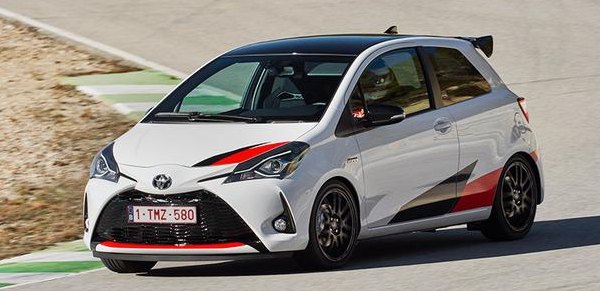
|
|
Akio
Toyoda revealed his wish that one day the Gazoo sub-brand would become
Toyota’s M or AMG…
|
|
Surprisingly, the first car to receive the GRMN treatment is Yaris, one
of the oldest cars in Toyota’s lineup. As its name suggested, its ride
and handling is tuned by Toyota's technical center located near
Nurburgring circuit, so we should not underestimate it. From outside,
you can already see some serious implications, such as the rear
spoiler, center exhaust and the 17-inch forged BBS wheels which save
2kg per corner. What you cannot see is even more comprehensive. The
suspension is lowered by 24mm by means of 60 percent stiffer springs.
The dampers come from Sachs. The anti-roll bars are thicker. The brakes
are larger (with 4-pot calipers up front). The front suspension is
reinforced by a tower bar while the monocoque is also strengthened by 4
additional braces and a stronger front subframe. The steering is
retuned and quickened. A Torsen LSD is fitted standard, while the tires
are stickier Bridgestone Potenza RE050A, sized 205/45R17.
Under the bonnet sits a 1.8-liter Dual-VVT-i engine fitted with a
Magnusson-Eaton supercharger and completed with charge cooler. Sounds
familiar? Yes, it is developed by Lotus and is the same unit fitted to
Elise, save different exhaust and cooling. It produces 212 horsepower
at an old-school 6800 rpm, very good for a supermini hot hatch. Torque
is not so, because the centrifugal type supercharger needs the engine
to rev to nearly 5000 rpm to produce the peak torque of 184 pound-foot.
Take a Peugeot 208 GTi by Peugeot Sport for comparison, it offers 4
extra horses at 1000 rpm higher the rev, but it produces 37 lbft less,
and it needs a further 3100 rpm to reach the torque peak. That said,
the Yaris is pretty light at 1135 kg, thus it is capable to do 0-60 mph
in 6 seconds flat and top 143 mph. That kind of performance puts it
just behind Audi S1 and Mini JCW. The little Toyota uses a conventional
6-speed manual gearbox to do so.
On the road, it is surprisingly good fun to drive. Well, maybe not so
surprising, because the GRMN’s mechanical design is old-school, so it
drives old-school. First of all, the little car feels quick. The Lotus
supercharged engine might lack low-down torque, but it responds quickly
to throttle, gathers punch linearly and is eager to spin to its 7000
rpm redline. It feels most enthusiastic between 5000 and 7000 rpm,
accompanied with a sporty exhaust note that could shame many small
turbocharged motors, so you will be happy to exploit the snappy
gearchange and push the car harder and harder. Sadly, this old-school
fun has been lost in many rivals in the name of modernization.
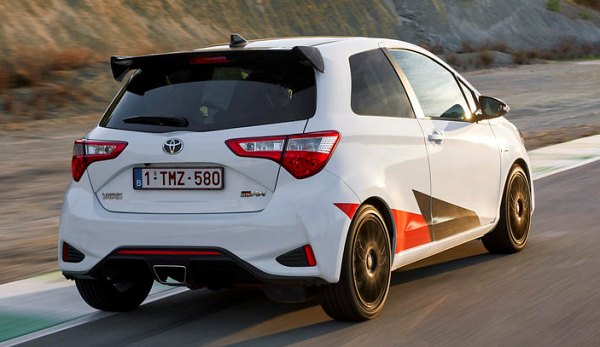
|
|
On
the road, it is surprisingly good fun to drive.
|
|
The handling is similar. The car feels tall, thus it will roll quite a
lot in corner, but once it is settled, you will find its Bridgestone
tires provide dependable grip and the LSD keeps the nose biting. The
steering feels surprisingly true. Pedals are well weighted, too. It
feels all in a piece. Although its balance is not as adjustable as Ford
Fiesta ST, its grip level is not excessive, so you can lift off and
apply brakes to induce a bit of oversteer. The suspension is quite firm
though. It might feel well damped on Nurburgring, but poor B-roads
could be more challenging.
The problems of this car is not driving dynamics, but the rest of the
package. The Yaris Mk3 is not exactly a good looking car, not even the
aggressive front grille and the rear spoiler can change the conclusion.
The cabin is a lot worse – uninspiring, cheap feeling and dated. The
driver seat is mounted 3 inches higher than keen drivers want. The
pedals are not ideally placed. The steering wheel is not adjustable
enough for tall drivers. The new bucket seats are better, what a pity
they don’t make the car any more special.
Then come the practicality issues other supermini hot hatches managed
to avoid. The GRMN’s bigger supercharged engine has a rated CO2
emission of 170g/km, a lot higher than Peugeot’s 125g/km. Even the
1.8-liter VW Polo GTi is good for 134g/km. Tax burden aside, the GRMN
is too expensive to purchase at £26,300. Admittedly, its
production is limited to 600 units – 400 for Europe and 200 for Japan.
While BMW’s M and Mercedes AMG are producing in the scale of 100,000
cars per annum, Toyota’s version is happy to be exclusive and
hand-built, just like the early M and AMG. I am just a little
disappointed that after waiting for so many years, the outcome is so
little. Hyundai is pushing much harder with its N brand, even though
the Korean group is not quite as profitable as Toyota. Maybe Akio
Toyoda should step up the effort. Let’s see if the next GRMN, the new
Supra, will be stronger.
|
Verdict:    |
|